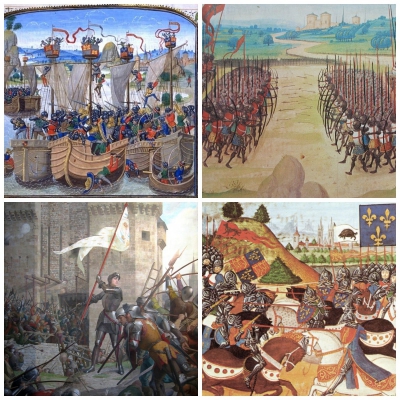The Battle of Sluys (; Dutch pronunciation: [slys]), also called the Battle of l'cluse, was a naval battle fought on 24 June 1340 between England and France. It took place in the roadstead of the port of Sluys (French cluse), on a since silted-up inlet between Zeeland and West Flanders. The English fleet of 120150 ships was led by Edward III of England and the 230-strong French fleet by the Breton knight Hugues Quiret, Admiral of France, and Nicolas Bhuchet, Constable of France. The battle was one of the opening engagements of the Hundred Years' War.
Edward sailed from the River Orwell on 22 June and encountered the French blocking his way to Sluys harbour. The French had bound their ships into three lines, forming large floating fighting platforms. The English fleet spent some time manoeuvring to gain the advantage of wind and tide. During this delay the French ships were driven to the east of their starting positions and became entangled with each other. Bhuchet and Quiret ordered the ships to be separated and the fleet attempted to move back to the west, against the wind and the tide. While the French were in this disorganised state, the English attacked.
The English were able to manoeuvre against the French and defeat them in detail, capturing most of their ships. The French lost 16,00020,000 men. The battle gave the English fleet naval supremacy in the English Channel. However, they were unable to take strategic advantage of this, and their success barely interrupted French raids on English territories and shipping. Operationally, the battle allowed the English army to land and to then besiege the French town of Tournai, albeit unsuccessfully.
The Hundred Years' War (French: La guerre de Cent Ans; Picard: Dgère d'Un Chint Ans; 1337–1453) was a series of armed conflicts between the kingdoms of England and France during the Late Middle Ages. It originated from disputed claims to the French throne between the English royal House of Plantagenet and the French royal House of Valois. Over time, the war grew into a broader power struggle involving factions from across Western Europe, fueled by emerging nationalism on both sides.
The Hundred Years' War was one of the most significant conflicts of the Middle Ages. For 116 years, interrupted by several truces, five generations of kings from two rival dynasties fought for the throne of the largest kingdom in Western Europe. The war's effect on European history was lasting. Both sides produced innovations in military technology and tactics, including professional standing armies and artillery, that permanently changed warfare in Europe; chivalry, which had reached its height during the conflict, subsequently declined. Stronger national identities took root in both countries, which became more centralised and gradually rose as global powers.The term "Hundred Years' War" was adopted by later historians as a historiographical periodisation to encompass related conflicts, constructing the longest military conflict in European history. The war is commonly divided into three phases separated by truces: the Edwardian War (1337–1360), the Caroline War (1369–1389), and the Lancastrian War (1415–1453). Each side drew many allies into the conflict, with English forces initially prevailing; the House of Valois ultimately retained control over France, with the previously-intertwined French and English monarchies thereafter remaining separate.

1340Jun, 24
Hundred Years' War: Battle of Sluys: The French fleet is almost completely destroyed by the English fleet commanded in person by King Edward III.
Choose Another Date
Events on 1340
- 1Apr
Gerhard III, Count of Holstein-Rendsburg
Niels Ebbesen kills Gerhard III, Count of Holstein-Rendsburg in his bedroom, ending the 1332-1340 interregnum in Denmark. - 24Jun
Battle of Sluys
Hundred Years' War: Battle of Sluys: The French fleet is almost completely destroyed by the English fleet commanded in person by King Edward III. - 30Oct
Battle of Río Salado
Portuguese and Castilian forces halt a Marinid invasion at the Battle of Río Salado.

 English
English  español
español  français
français  português
português  русский
русский  العربية
العربية  简体中文
简体中文 